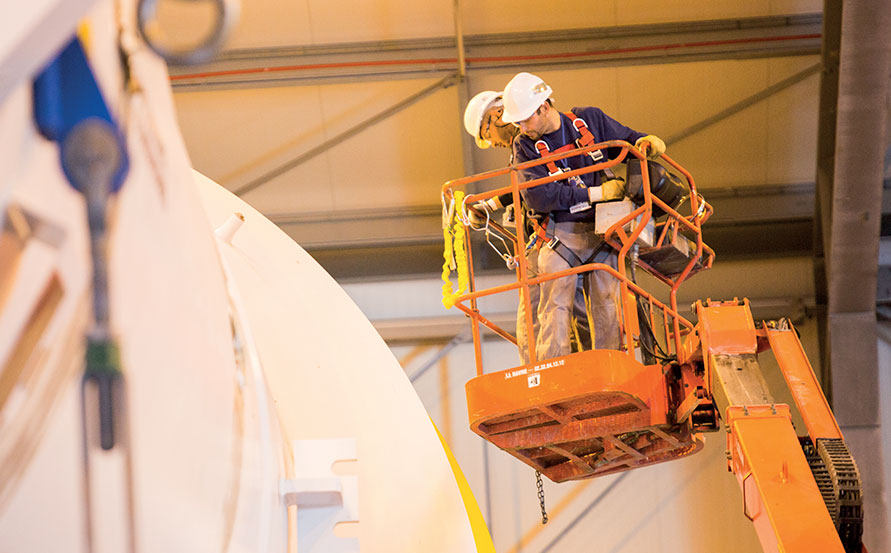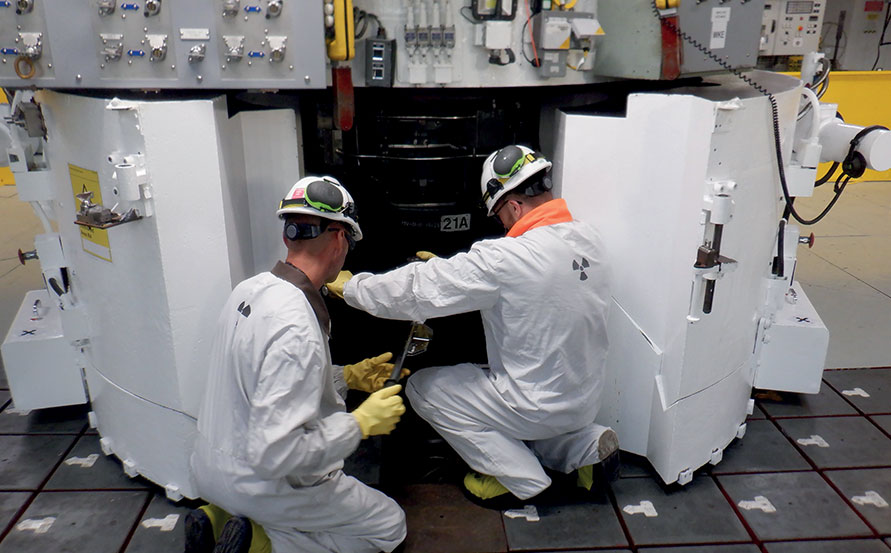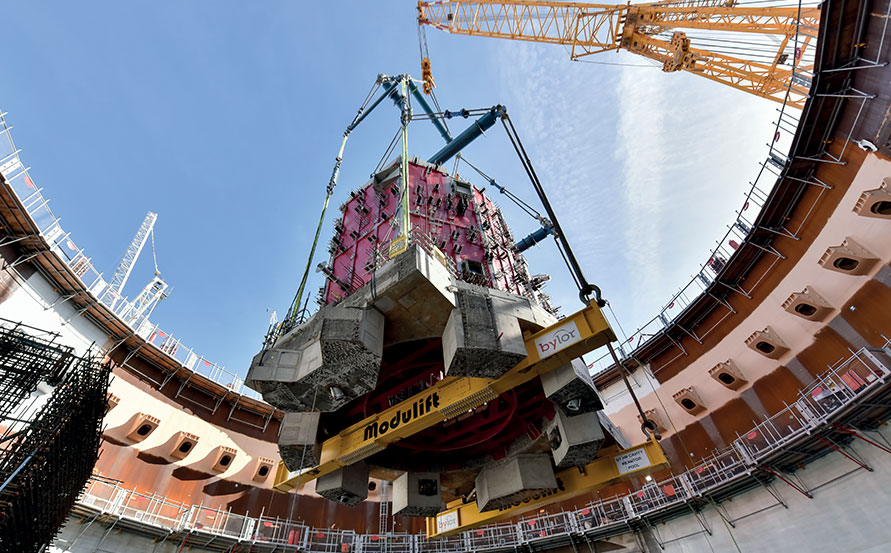- Home
- Foreword
- Contents
- 1. Retrospective and perspectives
- 2. At the heart of safety: high standards and leadership
- 3. Industrial safety and radiological protection: it’s behaviours that count
- 4. Pragmatism for the EPR2
- 5. The fleet upgrade: a colossal programme
- 6. Reactors that adapt to climate change
- 7. Nuclear fuel and reactivity control: the heart of nuclear safety
- 8. Competences: are we sufficiently demanding?
- 9. Changes in the electricity system: anticipate rather than suffer
- Appendices
- Contact
Navigation
Navigation
INTRODUCTION
Behaviours and respecting instructions protect workers, indicators only allow assessment of trends.
Massive recruitment and variable experience are putting industrial and radiological safety practices to the test.
The presence of management in the field should encourage good behaviour and create a culture of collective responsibility.
MANAGING PERFORMANCE BASED ON INDICATORS AND BEHAVIOURS
While indicators can be used to measure safety performance, they only tell part of the story, with the number of safety events being traditionally used. Lagging indicators do not capture the behavioural aspects, and using these as the sole measure of performance can render an organisation blind to the underlying factors. Leading indicators, however, help to identify organisational and behavioural gaps.
Leadership and behavioural safety programmes are designed to tackle behavioural causes. Field interactions help to understand the factors that influence behaviour and to create a collaborative approach. These programmes, which have been in existence since the early 1980s, have proved that leadership and the presence of management in the field increases workers’ commitment and their level of accountability, thereby improving safety performance and reducing the number of accidents.
During my visits, I again found that too much attention was paid to indicators and their management, compared to field observations and improving behaviours. I continue to observe events where behaviours were a contributory cause.
This recurring weakness is attributable to several factors common to both France and the UK, where recent safety programmes have solely focused on managers. High staff turnover and major recruitment programmes have led to a loss of experienced staff. In addition, there seems to be a lack of peer-to-peer challenge or reticence to challenge by workers who should be looking out for each other’s safety. Industrial safety and radiological protection are often perceived as a matter for experts rather than as an individual and collective responsibility.
Other factors are specific. In the UK, since the implementation of the Human Performance programme in the early 2000s, there has been no collective behavioural safety programme involving managers and workers. Over time, the departure of experienced employees has diminished this collective culture. In France, workers are still too inclined to implement countermeasures based solely on their perception of risks.
These shortcomings are recognised by Nuclear Operations and the Nuclear Production Division (DPN). The approach in the UK remains embryonic, with diverse improvement plans. In France, the improvement actions focus on training managers in the hope that they, in turn, will be able to positively influence employees and contract partners.
Behavioural safety
Most accidents are the result of poor behaviours. A behavioural safety programme therefore aims to strengthen the safety culture and is based on the principle of empowerment rather than the implementation of equipment or procedural solutions. The aim is to use field presence and observations to encourage the right behaviours and understand the factors influencing any deviations.
Such programmes have been in place for several years, for example, to reduce accidents at the Springfields fuel plant in the UK.
INDUSTRIAL SAFETY: GOING TO THE NEXT LEVEL
The safety indicators for DPN are achieving their objectives (see appendices). However, they are too dependent on administrative reporting procedures, and are difficult to compare with international standards. It is therefore essential to rely on the findings of field observations to enable comparison.
During my visits in France, I have noticed differences with the UK and the US. Safety expectations are still perceived by French workers as an obstacle to carrying out their work. Generational and social barriers persist: a young person still finds it difficult to challenge an experienced worker, and a subcontractor to challenge an EDF employee. Managers and supervisors are not aware of their legal responsibilities. Behind the signature on a risk analysis or accepting an isolation permit, do supervisors still have a clear understanding of the risks in the field and their responsibility to their teams?
In the UK, whilst the indicators are good (see appendices), there are indications that behaviours are declining. Nuclear Operations are aware of this trend, and I sense a real desire to arrest it with the aim of achieving international levels of performance.

The analysis of high and medium potential safety events (HPE and MPE) identifies trends in order to prevent dangerous situations and serious accidents from happening. At Hinkley Point C (HPC), improved near-miss reporting has enabled them to detect dangerous situations and implement corrective actions. This is all the more important in view of the ramp-up of electromechanical installation in 2024.
Results at Framatome remain stable. Over and above the arithmetical effects of integrating new entities (Framatome ARC at the end of 2022 and Framatome Grenoble in 2023), it highlights the need to support the increase in the volume of activities and staff, particularly on industrial sites, through strengthening risk prevention. The level of expectations for contract partners must also be more demanding. In 2023, the main contract partners each received a letter reminding them of Framatome’s safety requirements. Evaluation, selection and grading criteria for contractors must be suitable.
There were no fatal accidents relating to the Group’s nuclear activities this year. This positive record is the result of the sustained development of the industrial safety culture which needs to be continued. However, the fatalities in the Group that occurred during 2023 in connection with industrial activities, remind us of the importance of strict compliance with the rules relating to critical risks (work at height, live electrical work, risk of falling objects during handling, etc.).
Lifting: equipment conformity, competences and compliance with instructions
Lifting is essential to the maintenance of our sites. The associated risks are managed in a number of ways: training and qualification of personnel, risk assessment, written instructions, certification and inspection of equipment, and application of operating instructions. All these elements, when respected, guarantee the safety of personnel.
The failure to comply with these measures has resulted in serious injuries and the dropping of heavy loads. In France, a motor fell several metres near a reactor pool where the jib crane failed as a result of overload during lifting. Similarly, non-compliance with the operating instructions for lifting equipment led to a 110 kg load falling approximately ten metres.
In addition to these events, which reveal shortcomings in the operation of lifting equipment, there have also been shortcomings in equipment inspections and non-compliances with equipment conformity requirements. Audits and assessments have revealed the absence of certificates of conformity and maintenance histories for some lifting equipment.
A life-changing injury
A mobile elevated work platform (MEWP) driven by a qualified operator, under the guidance of a banksman, had to pass through a security gate to gain access to the site. The driver badged at the access gate to enter the protected area of the site, while the banksman had to badge at another pedestrian turnstile. Not complying with the expectation to wait for the banksman to return, the driver continued on their way and struck a pedestrian. The pedestrian fell under the MEWP and suffered severe crushing of his lower limbs, which resulted in amputation.
With 59 cranes on the HPC construction site in the UK, the site has a high level of lifting risk. To deal with this, lifting safety has been strengthened through the implementation of improved practices; installation of cameras on the hooks of 39 cranes to help crane drivers better identify hazards, reduction in the number of people involved in lifting activities, and increased competence. The standards associated with lifting have been updated to reflect these improvements. The electromechanical installation work in 2024 will pose new lifting challenges, particularly inside buildings. I urge the project to be vigilant during this phase of activity. I would also urge the Penly EPR2 project to transfer the HPC experience to the future construction site.
Electrical safety: the fundamentals that protect
Electrical work requires strict compliance with instructions because the consequences of electrocution can be fatal. It is essential that those working on electrical equipment protect themselves from danger by applying the basic fundamentals. Some practices are specific, such as testing that no voltage is present, correctly terminating cables and wearing personal protective equipment (PPE). Other practices, such as methods for preventing human error (HU tools), concern all workers and must be taken into account in the planning and preparation of electrical isolations and de-isolations.
I am still seeing a degree of complacency and inappropriate worker behaviour. Some electricians fail to test that no voltage is present, to terminate cables correctly, to wear the required PPE (face mask, specific gloves, etc.) or to use HU tools to confirm they are working on the right equipment. Tag-out engineers are also not using the HU tools effectively to ensure that the right equipment is isolated.
Electrocution at Romans-sur-Isère
Following a modification to a switchboard, the electrical isolation was removed so that functional tests could be carried out. Pending further modification work, compensatory technical measures were identified. Without explanation, the two technicians, who had carried out the original work, entered the switch room without authorisation. A few minutes later, an explosion and a flash occurred. The two workers were injured, one seriously injured to the face and eyes. A charred metal tape measure was found on site and the protective goggles in the helmet were not being worn.
ADDICTION PREVENTION: NEXT STEPS
Drug use is an offence punishable by imprisonment. Committing this offence in the course of one’s duties is an aggravating circumstance. The systematic drug-testing programme is designed to meet a number of objectives: employee health and safety, facility security and the Group’s reputation.
I note that the DPN now has a screening plan at all sites, but only two have implemented it in 2023. I am surprised to note that its deployment continues to be delayed by institutional and administrative resistance, particularly when reviewing draft amendments to the internal regulations. I call on all stakeholders, including the labour inspectorate and union partners, to ensure that 2024 can be the year in which these preventive tests are deployed at all sites for all staff, EDF and contractors alike.
I will be paying close attention to the measures taken on the Penly EPR2 site. I invite the project team to learn from the unfortunate experience of FLA3 and to draw inspiration from HPC’s good practices. These two sites are now carrying out tests that pose no acceptability problems; in 2023, approximately 11,000 tests were done at HPC, more than double of those done in 2022.
Since 2018, the procedures for carrying out testing have been included in the internal regulations of Framatome’s facilities.

RADIOLOGICAL PROTECTION: CHANGING BEHAVIOURS
Unlike conventional safety, the risks generated by ionising radiation or contamination are difficult to perceive. This characteristic affects workers’ behaviour. To remedy this, they need training, instructions and appropriate coaching. The aim is to influence behaviour by making the dangers clear and explaining the expectations.
In France, refresher courses (safety-security-quality-radiological protection) are not achieving their objectives. This is evidenced by a lack of understanding and respect for radiological work permits, forgetting to wear dosimeters and inappropriate actions when dosimeter alarms are activated. The shortcomings of these courses have been recognised by the DPN, who have asked the Operations and engineering training department (UFPI) to review the training arrangements.
The lack of consistency between sites in the application of radiological protection requirements adds to the confusion of contract partners. I request that this situation be remedied as soon as possible. Contractor personnel movements between sites are already significant and generate substantial risk without adding changing standards.
Three years ago, the DPN launched its radiological protection recovery plan, which has resulted in a reduction in the overall dose to workers and in the number of cases of contamination. However, although the radiological specialists have taken ownership of the plan, there are still major behavioural weaknesses in operations, maintenance and among contract partners. The self-declaration initiative for radiological controlled areas (RCA) implemented at certain sites is to be welcomed: it requires workers who do not have a fixed worksite to check themselves regularly and declare any contamination before exiting the reactor building.

At Flamanville 3, the RCA is in service in the fuel building and should be rolled out for training to all facilities several months before fuel loading. A significant preparation and training programme was carried out by the site to communicate the standards and expectations of working in the RCA. This is a good opportunity to learn best practice and adopt the right behaviours from the outset.
In the UK, non-compliance with radiological protection rules is analysed to identify gaps in knowledge and behaviours. This has made it possible to identify specific shortcomings and initiate targeted action plans that have already begun to bear fruit.
Radiography: a recurring problem in France
Radiography is a non-destructive inspection method for checking the quality of welds. The use of ionising radiation generates risks that are managed by rigorous processes and by the training and accreditation of specialist personnel.
The numerous events linked to radiography at French sites continue to alarm me and has been a recurring trend for several years. The performance of specialist contractors is a genuine concern and has been the subject of numerous improvement initiatives at the DPN.
Despite a robust training and accreditation process, I continue to see poor decision-making, and a lack of rigour in securing exclusion zones and using gamma-radiography equipment. These are all non- compliances with basic radiography practices. In addition, I also continue to observe events where workers do not respect the barriers and signs for radiography shots.
Radiography is very often an activity sub-contracted by welding contractors, which can dilute the control and supervision that EDF exercises. In the UK, however, all radiography activities on production sites are directly contracted by Nuclear Operations, who retains control and supervision of the service and ensures its safety.
At HPC, the number of radiography shots will increase in 2024. The project team is working to reduce the number of on-site shots or to minimise their impact. Simple and safe methods include increasing factory inspections, using reduced energy sources to minimise exclusion zones (Small Contained Area Radiography, SCAR) or using other non-destructive testing techniques such as phased-array ultrasonic testing.
Phased-array ultrasonic testing (PAUT)
PAUT is an advanced multi-element ultrasonic non-destructive testing technique. It has been deployed for some time in other highly regulated sectors such as petrochemicals. Probes, which are pulsed individually, create a phased beam that scans the inspection area to identify defects. This method has the potential to cover 67% of the radiographic inspection scope at HPC and will benefit Sizewell C.
Better containment of worksites
Maintenance in controlled areas requires radiological cleanliness, a working environment, and protective measures to prevent the dispersion of debris and the contamination of workers. In particular, this includes the installation of containments and airlocks.
In 2022, several notable contamination events occurred in the French fleet, and it is regrettable that these types of events have been repeated in 2023. Once again, competences and behaviours are the cause. Poorly constructed or operated airlocks, with inoperative ventilation, and failure to respond to alarms have led to internal and external contamination, including a skin-dose significant radiological protection event (ESR) classified INES 2, and evacuations of reactor buildings.
In the UK, only two internal contamination events occurred in 2023, both below the reporting level. The AGR design is favourable to radiological protection, which explains its good performance. The performance of the Sizewell B PWR (the only one in the UK fleet) is comparable to that of an AGR in terms of radiological cleanliness. Based on good historical fleet performance, the personal contamination event indicator was removed from the high-level indicators and replaced by trending behavioural shortfalls in the radiological protection rules. The remaining personal contamination events are small-scale and generally related to activities carried out during refuelling outages.
Contamination: every line of defence counts
In early 2023, approximately one hundred workers at a French site were exposed to varying degrees of contamination. This was due to the failure of several lines of defence on a steam generator tube inspection site in the reactor building. Investigations revealed faults in the static and dynamic containment of the airlock, faults in the monitoring of the surveillance beacons, even though they were functional, as well as a lack of experience of those involved and shortfalls in technical supervision. The reactor building was evacuated. Checks did not reveal any individual contamination above the declaration thresholds.

RECOMMENDATION
Despite recovery plans, problems persist in industrial safety culture and radiological protection. In both France and the UK, behaviours continue to be the cause of significant events. I recommend that the directors of the DPN and Nuclear Operations reassess their plans with a view to changing individual and collective behaviours in the field.
RECOMMENDATION |
Despite recovery plans, problems persist in industrial safety culture and radiological protection. In both France and the UK, behaviours continue to be the cause of significant events. I recommend that the directors of the DPN and Nuclear Operations reassess their plans with a view to changing individual and collective behaviours in the field.

